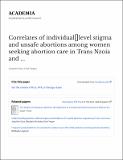| dc.contributor.author | Yegon, Erick Kiprotich | |
| dc.contributor.author | Mwaniki, Peter Kabanya | |
| dc.contributor.author | Echoka, Elizabeth | |
| dc.contributor.author | Osur, Joachim | |
| dc.date.accessioned | 2022-03-26T12:20:35Z | |
| dc.date.available | 2022-03-26T12:20:35Z | |
| dc.date.issued | 2016-08 | |
| dc.identifier.citation | Yegon EK, Mwaniki PK, Echoka E, Osur J. Correlates of individual-level stigma and unsafe abortions among women seeking abortion care in Trans Nzoia and Machakos Counties, Kenya. Ann Trop Med Public Health 2016;9:226-34. | en_US |
| dc.identifier.issn | 17556783 | |
| dc.identifier.other | e-ISSN 09746005 | |
| dc.identifier.other | DOI: http://dx.doi.org/10.4103/1755-6783.184787 | |
| dc.identifier.uri | https://repository.amref.ac.ke/handle/123456789/633 | |
| dc.description | This is an open access article distributed under the terms of the
Creative Commons Attribution-NonCommercial-ShareAlike 3.0
License, which allows others to remix, tweak, and build upon the
work non-commercially, as long as the author is credited and the
new creations are licensed under the identical terms. | en_US |
| dc.description.abstract | Objectives: To compare the levels of abortion stigma in regions with high and low incidence of unsafe
abortion in Kenya to explore whether abortion-related stigma is associated with incidence of unsafe abortion.
Study Design: A cross-sectional survey of 759 women receiving abortion services in private and public health
facilities in two counties located in regions with high and low incidence of unsafe abortion regions of Kenya.
Results: Of the total respondents, 424 sought postabortion care (PAC), whereas 335 sought induced abortion.
Factor analysis revealed a four-factor model for examining individual-level stigma related to seeking an abortion.
The mean of stigma scores for women in a Trans Nzoia was higher than in Machakos. (49.82 compared to 47.58,
P < 0.001). In the combined sample, respondents seeking PAC reported higher stigma scores compared to
those seeking induced abortion. For the overall scale and subscales, stigma reduced with increases in the age of
respondents (b = −7.7, P < 0.001 for 25–34 years and b = −4.6, P < 0.001 for 35–49 years). Regression analysis
showed that stigma decreased in the county with low incidence of unsafe abortion on interaction between with
type of abortion service. Conclusions: Respondents from a county with higher incidence of unsafe abortion
reported higher stigma scores compared to those from a county with lower incidence of unsafe abortion. Age,
marital status, type of abortion service, and socioeconomic status of respondents were all significantly associated
with stigmatizing attitudes across the stigma scale’s subscales. Young unmarried women, women who received
PAC low socioeconomic background, and married women reported higher stigma scores. | en_US |
| dc.description.sponsorship | Ipas | en_US |
| dc.language.iso | en | en_US |
| dc.publisher | Medknow Publications & Media Pvt. Ltd. | en_US |
| dc.subject | Abortion | en_US |
| dc.subject | Attitudes | en_US |
| dc.subject | Beliefs | en_US |
| dc.subject | Community | en_US |
| dc.subject | Kenya | en_US |
| dc.subject | Stigma | en_US |
| dc.title | Correlates of Individual‑level Stigma and Unsafe Abortions among Women Seeking Abortion Care in Trans Nzoia and Machakos Counties, Kenya | en_US |
| dc.type | Article, Journal | en_US |

